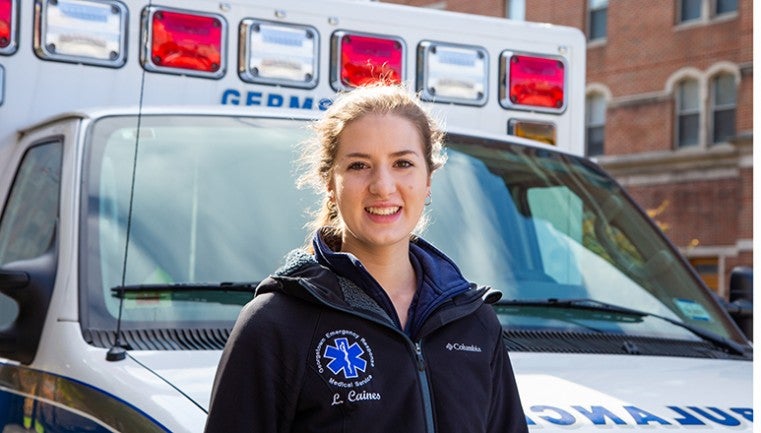One of the first and largest all-volunteer, award-winning student-run university emergency ambulance services in the country is based at Georgetown.
Operating 24/7 during the school year and summer with a two-ambulance fleet and a 77-member trained crew, Georgetown Emergency Response Medical Service (GERMS) answers hundreds of calls annually, helping students with everything from sprained ankles to mental health emergencies.
Lindsey Caines (NHS’19), a human science major from Rochester, New York, serves as crew chief and vice president of operations on the GERMS executive board.
Handled Competently
When called on an emergency, she shifts her ambulance into high gear on her way to answer a call, joined by two or three undergraduate certified emergency medical technicians (EMTs).
“This absolutely great group of students handles all types of emergencies and handles them competently,” says Dr. Jose Victor Nable, an attending physician at MedStar Georgetown University Hospital and medical director of GERMS.
The National Collegiate EMS Foundation (NCEMSF) recently named Nable Collegiate EMS Advisor of the Year, and Georgetown is one of four universities to be redesignated by NCEMSF this year as a HeartSafe campus. The designation requires that a minimum of 5 percent of the university community be trained in CPR.
With ambulances that provide basic life support services, GERMS is dispatched by the Georgetown University Police Department to answer calls on campus and the surrounding neighborhoods, including West Georgetown, Burleith and Foxhall.
GERMS also works closely with the Metropolitan Police Department. Caines said students should call GERMS – 202.687.HELP – if they or someone they know is sick or hurt.
Supervised by Professionals
When necessary, GERMS EMTs bring patients to MedStar Georgetown University Hospital or, in the case of critical trauma, to the George Washington University Hospital’s tertiary level emergency department.
As a nonprofit organization, GERMS does not bill patients for emergency response, medical assessment, treatment or transportation.
GERMS operates under the supervision of a MedStar Georgetown University Hospital Emergency Department-affiliated medical director and with the guidance of a Georgetown University faculty advisor.
Carol Day, director of health education services and an adjunct assistant professor at the School of Nursing & Health Studies, serves as GERMS’ faculty advisor.
“I could not be prouder of these students. They think outside the box, they run to unusual circumstances, they handle everything with ease,” says Nable, the GERMS medical director. “It has been a privilege to work with them.”
Calming Presence
Like many volunteers, Caines received her EMT training from GERMS as a first-year student.
During the school year, she does several six- or 12-hour shifts a week, plus more in the summer.
Caines believes that GERMS has helped prepare her to become a “compassionate doctor.”
She would love to go to Georgetown University School of Medicine and is strongly considering emergency medicine as her specialty.
“I now have a lot of insights into the struggles college students face,” she says. “It is harder to prepare for an anxiety attack than for a sprain. Regardless, I always try to be a calming presence, and I now know that every person and situation is different.”
